- Author Arianna Cook [email protected].
- Public 2024-01-12 17:55.
- Last modified 2025-06-01 07:38.
Characteristics of the anagallis flower, advice on planting and caring for a full-time color in a personal plot, how to reproduce, how to deal with pests and diseases, curious notes, species.
Anagallis is a member of the Primulaceae family, or as it is also called Primrose, which combines dicotyledonous plants that take on a wide variety of outlines, characterized by a spine-petal corolla. The genus, numbering about 34 species, growing in nature in territories that include European and American lands, as well as the African continent, the regions of the Middle East and the island of Madagascar. One of the species can be found in tropical climates in both hemispheres of the planet. In Russia and the countries adjacent to it, there is the only wild species of the field anagallis (Anagallis arvensis).
| Family name | Primroses or Primrose |
| Growing period | One-, two- or multi-year |
| Vegetation form | Herbaceous |
| Breeds | By seed method or vegetative (by cuttings or dividing the bush) |
| Open ground transplant terms | April May, when the soil warms up well |
| Landing rules | Saplings are placed at a distance of 20-25 cm from each other |
| Priming | Lightweight, loose, well-drained and fertile |
| Soil acidity values, pH | 6, 5-7 (neutral) or higher 7 (calcareous) |
| Illumination level | Well-lit place or light partial shade |
| Humidity level | Moderate and regular watering |
| Special care rules | Weeding and fertilization recommended |
| Height options | Within 10-30 cm |
| Flowering period | From early summer to September |
| Type of inflorescences or flowers | Single flowers |
| Color of flowers | Bright orange or reddish brick, blue or white |
| Fruit type | Polyspermous capsule |
| The timing of fruit ripening | As the flowers are pollinated |
| Decorative period | Summer-autumn |
| Application in landscape design | Planting in flower beds and flower beds, as a ground cover in rockeries or rock gardens, as an ampelous culture in garden containers |
| USDA zone | 8-10 |
Anagillis got its name from the combination of a pair of Greek words "ana" and "agallein", which translate as "base" and "delight", respectively, which describes the process of flowering and opening of buds, depending directly on environmental conditions. According to recent studies based on genetic and morphological characteristics, the plant has come to be considered a relative of the Mirsinoideae. The people can hear the name "full-time color", which indicates the type of open corollas. Because of the poisonous substances that saturate the parts of the plant and are harmful to domestic animals, one can hear the nicknames kouroslep or curomor.
In the genus Anagallis, there are both perennial representatives and those whose vegetation cycle lasts only one or two years. The thin root takes on a rod-like shape. All species have a herbaceous form of growth. The tetrahedral stems of full color are tender and ascending, can grow simple or have ramifications. The color of the shoots is green (light or dark shade). Plant height reaches only 10-30 cm, but the length of the stems can reach up to half a meter and during the flowering period the diameter of the bush is about 0.5-0.6 cm. Through the stems, colorful clumps are formed, resembling decorative rugs.
Annagalis leaf plates, unfolding on stems, are devoid of petioles and grow sessile in opposite sequence. Despite their small size, the leaves give the plant a decorative effect with their rich green color scheme and a glossy surface that gleams in the rays of sunlight. The shape of the leaf plates is ovoid, but occasionally they are annular. The foliage is whole-edged. In rare cases, leaves can even grow at the ends of the stems, which is why they are called alternative.
Anagallis buds open with the arrival of the first summer days, and this process can stretch until September, and sometimes even until the first frost. Full-color flowers usually grow on elongated pedicels that originate from the leaf axils. In the calyx of the flower, there are five sepals with subulate or lanceolate outlines, the lobes grow deviated. Annagalis has a wheel-shaped corolla, but it can take on a bell-shaped or funnel-shaped shape. The corolla tube is shortened, often so short that it seems that the petals are formed spaced apart from each other.
There are five such falling petals in the corolla. Their color can be bright orange or brick-red, but they can be blue or snow-white. Inside the corolla of the anagallis, there are five stamens, which grow free or, in rare cases, grow together. The pistils have threadlike columns and a blunt stigma. During flowering, the buds open gradually, which ensures the duration of the process.
Curious
Flowers of full color will stand open, only in the direct rays of the sun, if it is hidden behind clouds, then the corollas are immediately closed.
In anagallis, from the ovary, a fetus is formed, represented by a polyspermous capsule. Such a filmy box has a spherical shape and, when fully ripe, it cracks across. Inside the fruit there are small seeds, characterized by a conical contour in the front, and flattened at the back.
Plants of full color are unpretentious and, with simple care, will become an excellent decoration of the site, in addition, there is also a medicinal effect known to folk healers for a long time, thanks to which such bushes can be planted on a medicinal garden.
Important
When growing anagallis, it is necessary not to forget about the saturation of its parts with anagallis-saponin, which makes the plant poisonous, therefore, during any operations with it, it is recommended to use gloves and plant in places inaccessible to small children or pets.
Analallis: planting and caring for a flower in the open field
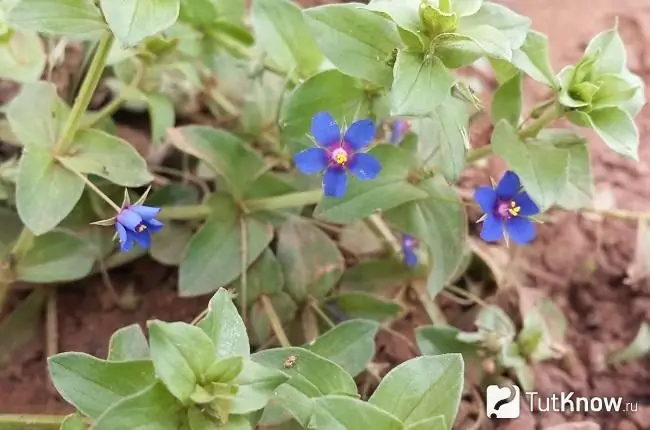
- Landing place anagallis should be selected open, but so that direct sunlight could not harm the delicate leaves. That is, it is necessary for successful growth and flowering several hours of direct ultraviolet fluxes, which is possible in the western, eastern, southwestern or southeastern locations. Do not plant in lowlands or where moisture from melting snow or rains can stagnate.
- Priming when cultivating anagallis, it is recommended to select a loose one, preference should be given to infertile substrates with an admixture of lime, that is, the acidity indicators of the soil mixture can be neutral (pH 6, 5-7) or alkaline (pH above 7). If the soil at the planting site does not meet the requirements, is too acidic or heavy, then in the first case dolomite flour (or slaked lime) should be mixed into it, and in the second, the substrate should be mixed with river sand.
- Planting anagallis held at the end of April or with the arrival of May. It is important when planting in the hole to lay a sufficient layer of drainage, since waterlogging is detrimental to full color. As a drainage material, you can use coarse sand, fine expanded clay or crushed stone. A seedling is placed in the planting hole at the same level as before, it should not be buried. After planting, the soil around is slightly squeezed and abundant watering is carried out.
- Watering when caring for anagallis in the garden, it is not necessary, but it is recommended to moisten the soil in summer heat or drought, if the plants are placed in a southern sunny location. If the full color is planted in a garden container, then regular watering is indispensable. But then you should ensure the planting with high-quality drainage so that the water in the container does not stagnate. Since the plant is drought-resistant, waterlogging of the soil is destructive for them. When caring for anagallis, watering is optimal no more than 2-3 times a week. At the same time, it is important not to allow waterlogging of the substrate, as it will entail rotting of the plant root system. At the same time, air humidity does not play a role when growing full-time color.
- Fertilizers when growing anagallis, you can not use it if the planting was carried out in nutritious garden soil. But the plant will gratefully respond to the introduction of rare dressings. Complete mineral complexes (such as Kemira-Universal or Fertiki) or compost are suitable. Top dressing should be applied twice: the first before planting and the second at the end of summer.
- Anagallis transplant required if the plant is planted in a garden container. As the bush grows, the size of the container needs to be increased. Wide pots of shallow depth are best suited for full-time color. What material they will be made of does not matter at all. Spring days are suitable for transplanting. Since the root system of anagallis is tender, it is recommended to use the transshipment method when the earthen ball will not collapse.
- General advice on care. Since anagallis can actively reproduce by self-sowing and because of this in agriculture it is considered to be a weed, then when the flowers begin to wither, it is better to remove them without waiting for the fruits to set. Like an ordinary garden plant, periodic loosening of the soil will be needed here, especially after watering or rain and weeding from weeds. If the full color is contained in room conditions, then regular ventilation of the room will be useful for it, but at the same time they try to provide protection from drafts.
- The use of anagallis in landscape design. It is recommended to use Anagallis monellii when shaping the curbs, these plants will also look great in hanging baskets or garden containers. In such baskets or pots, it is recommended to interfere with several bushes at once, for greater decorativeness. Anagallis looks good in the voids between stones in rockeries or alpine hills, such bushes can be used to decorate empty spaces in flower beds and flower beds. Excellent neighbors for blue anagallis are seaside alissum (Lobularia maritima), as well as Ursinia, Nemesia Nemo Yellow or orange (Nemesia Sunsatia Kumquat).
See also the rules for planting a straw and growing outdoors.
How to reproduce anagallis?
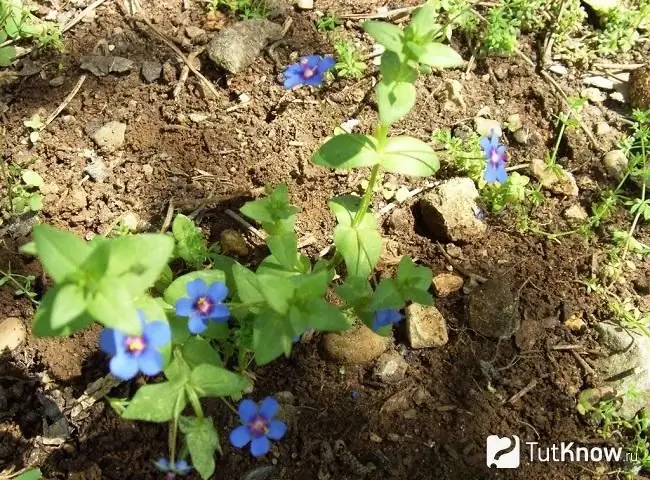
To grow full-color bushes on your site, a seed reproduction method is used. But at the same time, sowing is possible both directly into open ground, and growing seedlings. Also, some gardeners use vegetative propagation (by cuttings or dividing the bush).
Reproduction of anagallis using seeds
Using the seedling method, seeds are sown throughout March-April. Since they are very small in size, it is recommended to mix the seeds with fine sand to facilitate the sowing procedure. For comparison, one gram contains about 150 seeds. To grow a hundred young bushes, it is recommended to take 0.5 grams of seed. A nutritious and loose soil mixture (composed of river sand and peat crumbs) is poured into the seedling boxes and the seed is distributed on the surface of the soil. After that, the seeds can be lightly covered with a thin layer of the same soil. Watering is carried out by spraying the surface of the substrate from a finely dispersed spray bottle so as not to wash out the sown anagallis seeds.
A piece of glass is placed on top of the seedling box or covered with plastic wrap. This will help create a greenhouse environment that will maintain warmth and humidity. Caring for crops of full color is regular moistening of the soil surface, if it begins to dry out, and periodic ventilation. The temperature for successful germination should be between 18-20 degrees.
Important
Waterlogging of the soil will lead to decay of anagallis seeds, so it is better not to overdo it with watering here.
After 7-15 days, shoots of full color can be seen on the soil surface, but the germination of seedlings is not uniform. The shelter during this period can be removed, and the box with seedlings can be placed in a more illuminated place, but shaded from direct sunlight. Spraying foliage from a fine spray gun is suitable as watering. To stimulate branching, the tops of the shoots of the bush should be pinched. With this reproduction, you can enjoy the flowering of anagallis already in the last week of May or from the beginning of summer days.
If sowing was carried out directly on the flower bed, then such bushes of full color will begin to bloom later, but this process will stretch until frost. When the seedlings of anagallis appear, they are performed after a couple of weeks of thinning, leaving a distance between the plants of about 20-25 cm. Moderate watering is also necessary for such "young".
Propagation of anagallis by cuttings
It is recommended to cut blanks for this in mid-May. After that, the cuttings are treated with any rooting stimulant (for example, Kornevin), but if this is not the case, you can simply dilute the water with aloe juice. Then the twigs are planted in containers filled with sandy-peat soil and placed under a glass or plastic cap (you can take a jar or bottle). In the process of rooting, it is recommended to water the cuttings of full color and air for 10-15 minutes daily. When the seedlings take root, and this will become clearly on the blooming new leaves, you can transplant into the garden. Flowering of such plants should be expected after 2 months from the moment of planting.
It happens that the harvesting of anagallis cuttings is carried out in the autumn, while planting is also carried out in pots, and then the seedlings are grown at room temperature and moderate watering. Only with the arrival of spring, you can perform a full-color transplant to a flower bed.
How to deal with pests and diseases when growing anagallis in the garden?
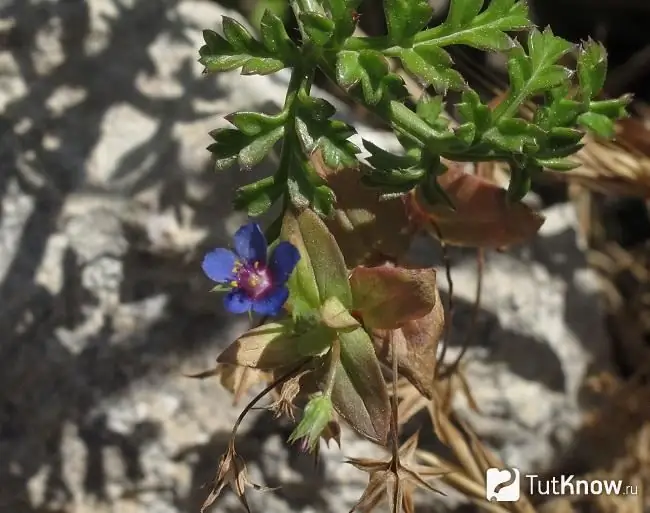
A problem when growing full color in open ground conditions is waterlogging of the soil from an incorrect irrigation regime or too long precipitation. The plant reacts to such a violation in leaving with leaves that acquire a yellow color. If this does not apply to the incorrectly chosen planting site, then it is recommended not to water anagallis for 14-20 days in order for it to recover. If the landing site is not chosen correctly, then you will have to immediately carry out a transplant.
Also, a sign of an incorrectly chosen location for growing full-time color is burns of delicate leaf plates. If the plant is kept in a pot, then it should simply be moved to another place with diffused lighting. Otherwise, it is also necessary to carry out a transplant.
A big problem when growing anagallis is a pest such as aphids. These small insects reproduce rather quickly and their colonies, completely covering the shoots and leaves of the plant, can reduce the rate of growth of stems and formation of buds for a whole month. Aphids suck nutritious juices, while many infections get into the wounds inflicted by these insects, while the pest is a carrier of viral diseases that cannot be treated, and then all plantings will have to be removed.
Aphids are easy to see from the back of the leaf blades, on the tops of the stems or on the buds of anagallis. The color of such small bugs is green, black or whitish. Also, in places where harmful insects are present, a whitish, dust-like plaque forms (padi is a product of the vital activity of bugs), which becomes a favorable environment for the spread of various fungal diseases and mold.
To combat aphids, plants can be planted in an area near the anagallis, which will scare off the presence of phytoncides or essential oils in their parts. Such representatives of the flora are onions or garlic, as well as all kinds of spices: parsley and dill, fennel, basil and the like. Medicinal plants that can be planted between flowers in the garden can also help in the fight against aphids, among them lavender and mint, lemon balm and thyme are given priority. Scare away from the site not only aphids, but also nematodes will help the rows placed on them with pyrethrum or marigold.
But it is clear that if aphid colonies are found on the stems of anagallis, then the fight should be started immediately, and both folk and chemical preparations can be suitable for this. As the first ones, I can act as infusions from onion peels and garlic gruel, solutions from grated laundry soap. Aktara and Aktellik, Deces and Karbofos are recognized as chemicals that always provide a positive result.
Often, such treatments are combined with etching against fungal diseases using fungicides such as Fundazol or Skora.
Curious notes about anagallis
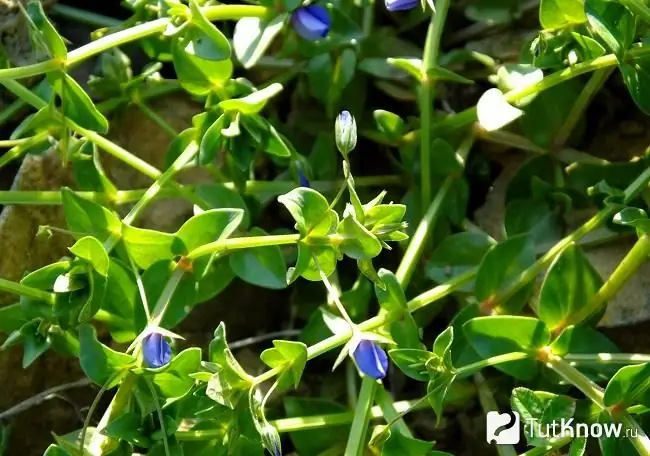
Despite its decorative effect, full bloom often grows as a weed in uncultivated land, in fields and landfills. But since in its parts the plant contains such a substance as anagallis-saponin (which is also very poisonous), it has long been used in folk medicine for the treatment of rabies (although there is no exact data on the success of such a treatment). Such preparations, prepared on the basis of dried herbs, help get rid of melancholy and cancer, epilepsy (or as it is called falling sickness). We used tinctures and decoctions from anagallis for diseases of the kidneys, lungs and liver. Such drugs had a calming effect and quickly promoted wound healing.
Types and varieties of anagallis
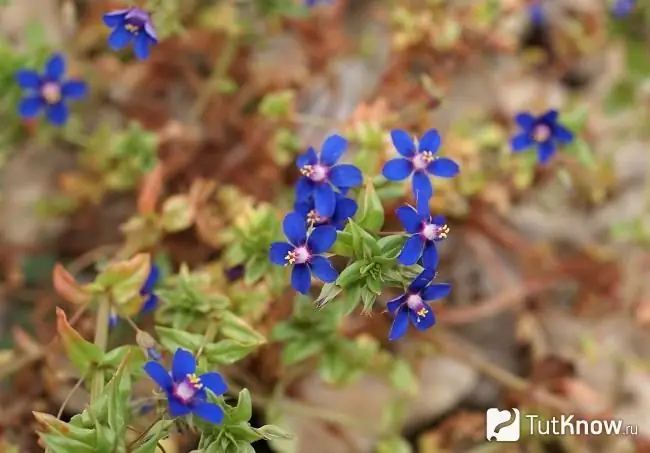
Blue Anagallis (Anagallis foemina)
may occur under the name Anagallis caerulea or Pimpernel … The height of the plant does not exceed 15 cm. During summer flowering, stretching until October, funnel-shaped flowers appear from the leaf sinuses. The color of the petals in the corolla takes on a bright and rich sapphire hue. The diameter of the flower reaches 8 mm when fully expanded. Flowers are open only in clear weather, if the days are cloudy or with the onset of evening, the corollas immediately close. Recommended for use in flower beds, in hanging baskets or for planting in garden containers.
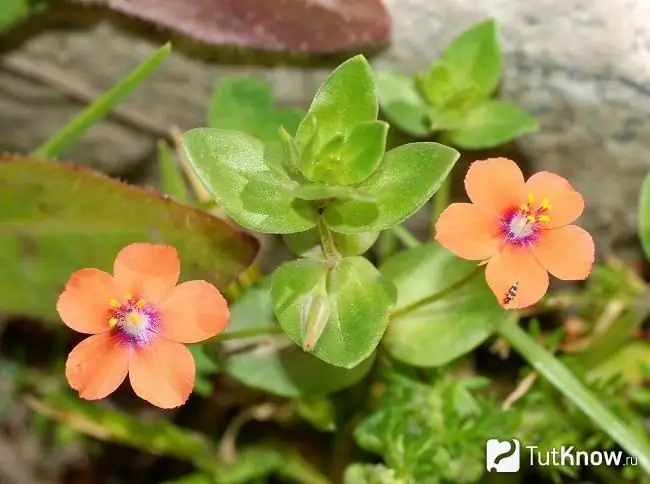
Anagallis bright red (Anagallis arvensis)
has a fairly wide natural distribution. In nature, it settles among shrub thickets and in meadows. Flowering begins in May and lasts until the first frost. Flowers on stems are small. Their diameter can be measured 5-8 mm. The petals in flowers, justifying the specific name, have a bright red tone. When the weather is bad, the corolla petals close tightly. The view is used to frame garden paths or steps, the voids in flower beds are beautifully filled with bushes.
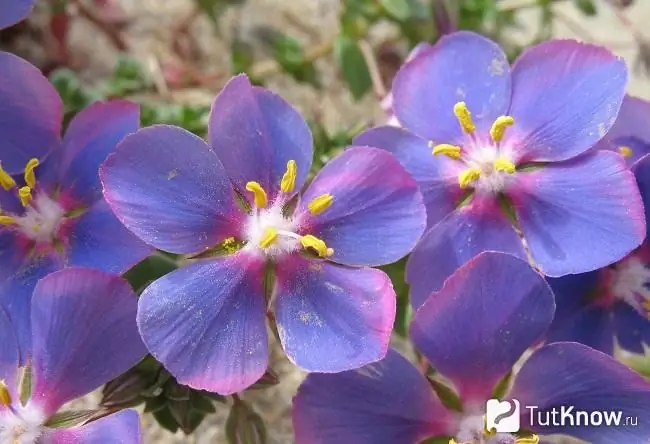
Anagallis monellii (Anagallis monellii)
is a tall garden form. The stems of the bushes can be equal to 0.3 m in height. The flowers, when opened, are characterized by larger sizes, about 2.5 cm in diameter. The stems have branching. Through the shoots, a spherical bush is formed. In the evening and at night and in non-sunny weather, the corollas are closed.
Anagallis Monelli species can suffer from rot and therefore, when planting, it is recommended to choose a well-permeable soil and apply a layer of drainage material. After flowering, active fruiting begins. When the seeds are fully ripe, they acquire a dark brown or black color. Seed germination remains high for 8 years, but seeds should be stored in a dry and cool place.
Among gardeners, the following varieties of Anagallis Monelli are popular:
- Jenshen Blue (Gentian Blue) or Blue buckwheat perennial with a compact bush shape. Bloom throughout the summer until October. Ideal for containers, mixed patio plantings or formal flower bed layouts, prefers a sunny position. This species was known as the Italian pimpernel in 1795 when it was described in Curtis's botanical journal. The color of the petals is deep blue, at the base of the petal there is a pink edge, anthers are bright yellow. Height varies between 15-30 cm with a width of about 12-25 cm.
- Skylover or Sky lover) or Sky lover - Anagallis Monelli variety characterized by attractive bright blue flowers that appear almost continuously from late spring to the first frost on neat creeping stems. Height 25-30cm when spreading and stems 30cm. A perennial applied to the front of curbs and rockeries can be used in addition to pots, window containers, and even hanging baskets where the creeping stems can cascade smoothly around the edges. It is best to bloom in full sun, although it will also withstand light partial shade.
- Blue Bird or Blue Bird, very suitable for a "southern garden" and open space without trees and shrubs. It is an annual plant that requires a sunny, warm spot in soil that is not too poor and in a non-shady area of trees and shrubs. It can also be recommended for use in rock gardens and on a stone wall. Works well with "stone plants" as long as the soil does not get too dry at the planting site. Great for pots and garden containers. The plant has strong stems and is good. The color of the flower is blue and the flowering time is from July to October. Leaves are green and about 10 cm. Stems of adult specimens reach no more than 20-25 cm. Withstands temperatures up to 5 degrees Celsius.
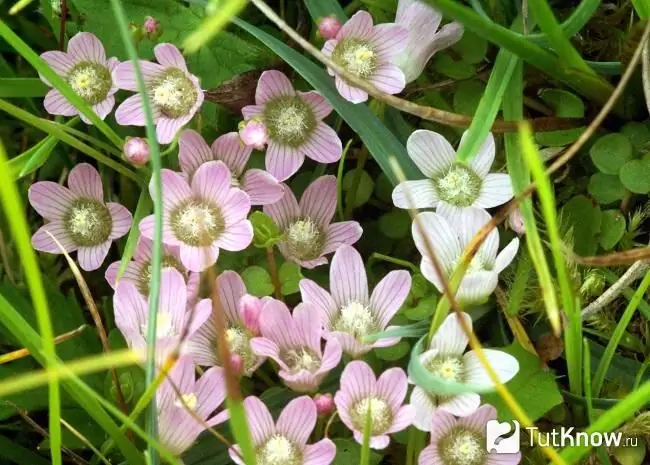
Anagallis tender (Anagallis tenelle)
is quite rare. It carries its specific name because of the color of the petals in the corolla. They take on pastel shades of pink, purple or whitish. But additional attractiveness is created by stripes on the petals located longitudinally on their surface. The stems are also fragile and require careful and careful handling during cultivation. The foliage on them is characterized by heart-shaped outlines and a pale green color. Growing requires moist soil and abundant watering. It can multiply both by seeds and by dividing the bush.
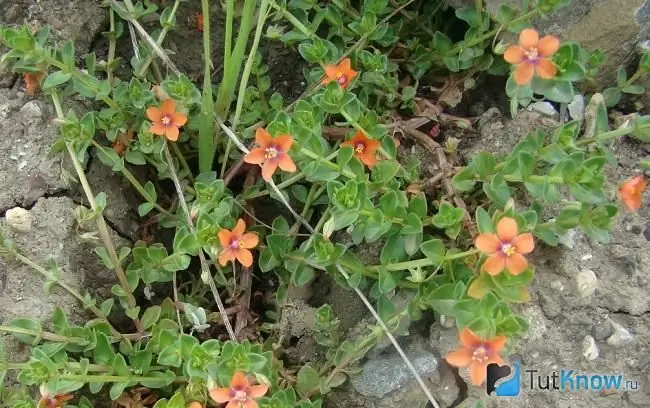
Field anagallis (Anagallis arvensis)
is the most unpretentious species in the genus. Under natural conditions, it can grow in the form of a weed, growing on wastelands or along roadside shoulders. It is found on the lands of the African continent (western and northern regions) and in Europe, but naturalization took place in the central and eastern Asian regions, in North and South America, in India and Malaysia, on the islands of Oceania and southern Africa, as well as on the Australian continent.
Stems of anagallis field grow creeping, small bright green leaf plates unfold on their surface. The length of the shoots can stretch up to half a meter. The surface of the ovoid leaves is covered with black specks. During summer flowering, stretching until the first frost, numerous flowers with petals of a red, orange or blue hue originate on the shoots from the leaf sinuses. Recommended for cultivation as a ground cover crop.
Such bushes of anagallis field will cover empty spaces in rockeries or rock gardens. With their help, curbs are formed or planted in garden containers. The soil should be selected light, with good permeability, calcareous. When grown as a houseplant, the pot should be kept on a southern windowsill and growth will resume in spring. Can also be grown outdoors and in southern regions. When fruiting, the multi-seeded capsules ripen, in which there are several hundred seeds, suitable for reproduction.
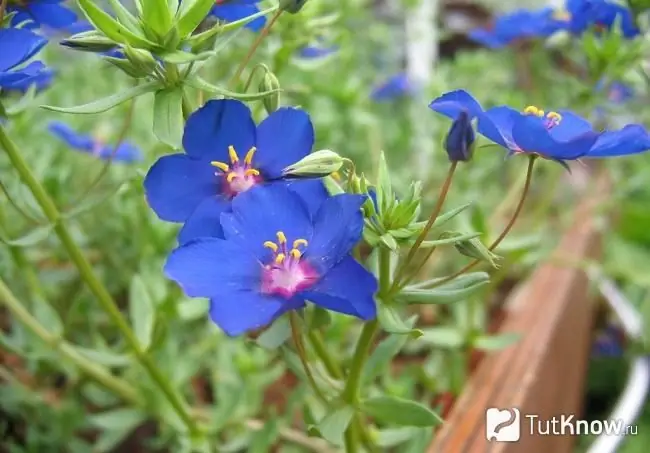
Anagallis large-flowered (Anagallis x grandiflora)
is a hybrid species from Mediterranean lands. It can often be confused with Lysimachia foemi, a plant that has a similar flower shape, but its leafy plates are wide and grow in cold climates. The species is characterized by undersized creeping stems, is a perennial. Due to hanging stems, it can be used as an ampelous pot culture.
Wild plants of the large-flowered anagallis with blue petals in the corolla are often found in southern Spanish regions, specimens with orange flowers come from southern Italian lands and are found in Morocco. There are varieties with red-colored petals in flowers, which were bred by breeders of the University of New Hampshire. The classic color of wild varieties is a snow-white tone. When grown in temperate climates, large-flowered anagallis will grow as an annual plant.
Related article: How to care for a cyclamen
Video about growing anagallis in open field conditions:









